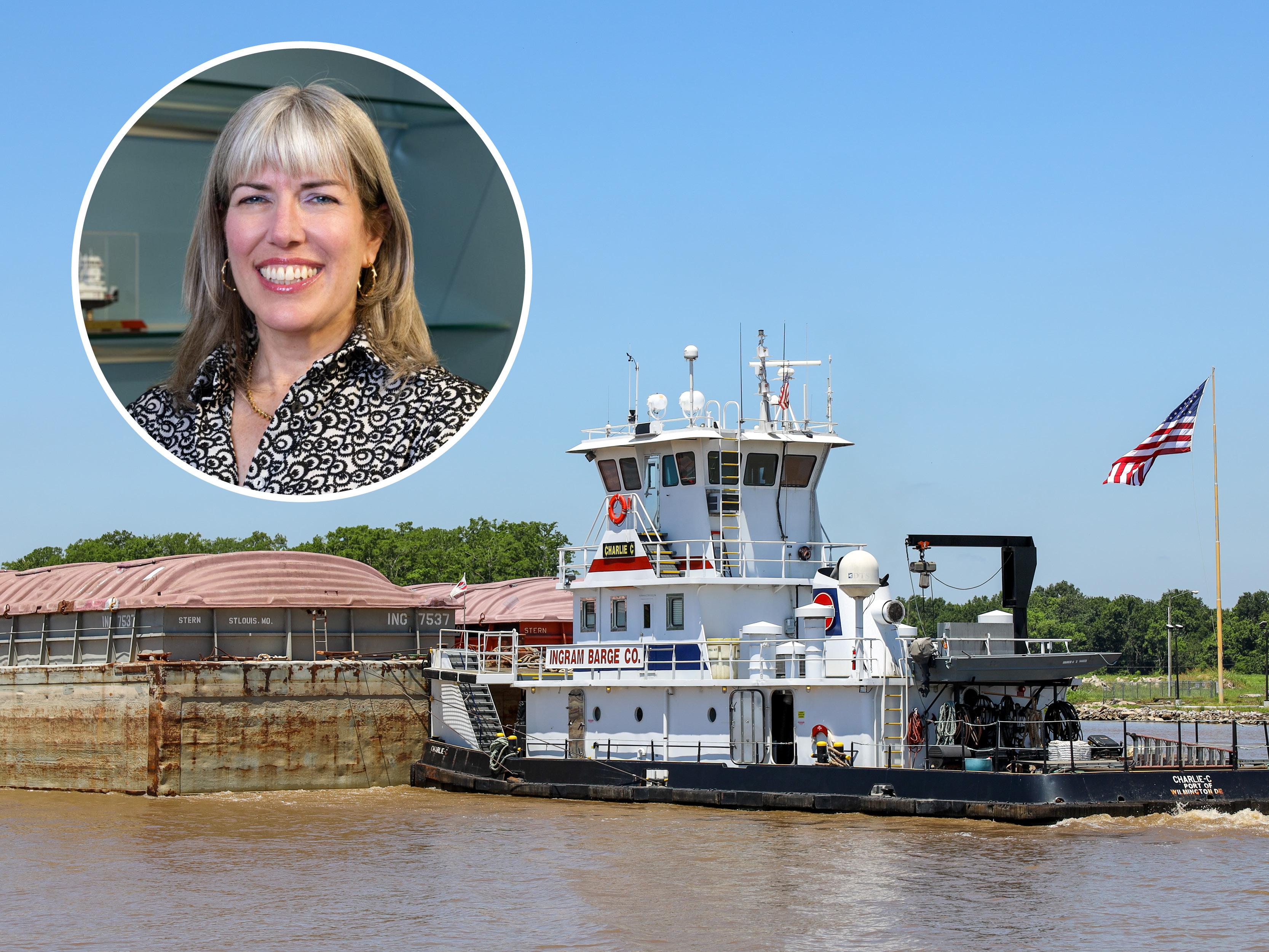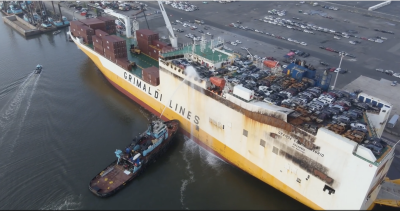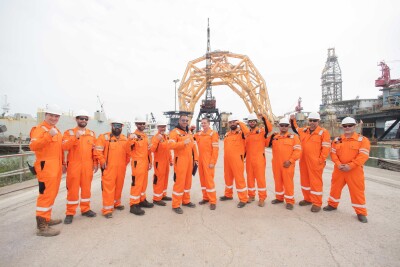WorkBoat: To start off, can you tell us what you think is the biggest challenge for the inland waterways industry going into a new year that is filled with so many uncertainties? What are AWO’s biggest priorities?
Jennifer Carpenter: Inland and coastal tugboat, towboat, and barge operators are cautiously optimistic as 2022 gets underway. There’s no question, challenges and uncertainty abound. We don’t know how the war in Ukraine will affect the world and the U.S. economy. We don’t know whether there’s another Covid variant lurking out there. We don’t know what severe weather an increasingly volatile climate will bring this year. We continue to deal with a significant labor shortage, and the global drive for decarbonization is the definition of profound and disruptive change. But our industry is stress-tested, adaptable, and resilient, as we’ve demonstrated again and again. And there are some real bright spots out there — stronger demand signals for both dry and liquid cargo, exciting new markets like offshore wind, the successful end to the Sub M COI phase-in approaching, and historic investment in waterways infrastructure with the enactment of the Infrastructure and Jobs Act. In 2022, we’ll be focused on helping our industry beat back the challenges and seize the opportunities before us today and creating the conditions for its future success. We’ll do that by … maximizing opportunity for our industry in the emerging offshore wind market, ensuring that Coast Guard regulations keep pace with technological evolution and don’t become a barrier to improved safety and efficiency, and providing relief from burdensome costs like towing vessel inspection user fees.
WB: Congress recently approved a major funding investment in U.S. infrastructure that included over $2 billion for inland waterways. How far will this money go for waterways improvements given the large backlog of projects that exist? Is it just for construction, or are funds also available for operations and maintenance?
Carpenter: It’s transformative. Combined with annual appropriations, the new funding provided by the Infrastructure and Jobs Act could allow two-thirds of the priority inland waterways infrastructure projects in the Capital Investment Strategy to be funded to completion, and there’s an additional $4 billion for operations and maintenance. The Capital Investment Strategy, a collaborative effort by the Corps and the congressionally authorized Inland Waterways Users Board to prioritize inland waterways infrastructure projects, is an important existing mechanism to make sure this money is spent wisely. In January, the Corps of Engineers released its spending plan for the new funding, based on the CIS, and it’s great news — Kentucky Lock, Montgomery Lock, Lock and Dam 25, Three Rivers, and T. J. O’Brien Lock and Dam would be funded to completion. All of this is hugely positive.
WB: How have supply chain and labor problems that have led to a backup of containerships idle off many U.S. ports affected the tug and barge industry?
Carpenter: Tugboats, towboats, and barges – and the domestic maritime industry overall – have been supply chain heroes. In contrast to the dislocation and skyrocketing freight rates that we’ve seen in the international maritime trade that have resulted in delays and backups at U.S. ports, the domestic maritime industry has provided consistent, reliable, timely service throughout the pandemic and the supply chain challenges of the past two years. The contrast is striking, and it’s another reminder of the value of the Jones Act to our country. Imagine what would have happened if Americans living in Hawaii or Puerto Rico had to rely on foreign vessels instead of dedicated Jones Act service to keep them supplied with essential goods? We know exactly what would have happened — empty shelves and skyrocketing prices.
WB: Offshore wind energy projects are revving up on both coasts and in the Gulf of Mexico. What kinds of opportunities does this present for the waterways industry? What is the significance of a new federal requirement that all offshore renewable energy projects be subject to the Jones Act?
Carpenter: Offshore wind is the biggest new market for the maritime industry in decades. Dozens of vessels will be needed on every offshore wind project and at every stage of the offshore wind project lifecycle, from site preparation to installation to operations and maintenance and, eventually, decommissioning. Thanks to Congress’s clarification of the statutory ground rules, the lion’s share of this new work will go to U.S. vessel owners, shipyards, and mariners. On January 1, 2021, the Mac Thornberry National Defense Authorization Act was enacted with overwhelming bipartisan support. Among its important provisions was one clarifying that the Constitution and all U.S. laws, including the Jones Act, apply to renewable energy development on the Outer Continental Shelf (just as they do to oil and gas).
WB: And how does AWO balance its excitement for this developing energy resource and the business opportunities it presents with concerns about navigational challenges that wind farms present for vessel operations?
Carpenter: AWO members are deeply committed to safety and environmental sustainability, and there’s no reason we can’t have both with proper planning. The best way to ensure navigation safety around wind farms is to create fairways – dedicated traffic lanes – for navigation that are off-limits to development of any kind. That needs to happen ASAP, and as the lead federal agency with responsibility for navigation safety, the Coast Guard’s leadership and timely action is essential. We need fairways now so that the Bureau of Ocean Energy Management can take them into account in leasing areas for wind energy development. Leasing wind energy areas first and then trying to figure out how to navigate safely around them is backwards, and a recipe for increased safety and environmental risks.
WB: Labor was hard to find and retain before the pandemic and the situation has worsened as inland companies are feeling intense competition from many other industries for workers. How are companies responding?
Carpenter: Our industry has both an acute, near-term labor challenge, exacerbated by Covid and competition with land-based businesses that have increased wages dramatically over the last year, and a longer-term need to ensure that we’re an employer of choice for a new generation of mariners and shoreside employees. But the opportunities for life-changing, meaningful, well-paying careers are tremendous, and hard to equal in other sectors of the economy. A young person with a high school diploma or a GED can start green on deck and work their way to the wheelhouse, earning a six-figure salary and great benefits, in less than a decade. So, we’ve got to do more than throw money at the problem in the form of rising wages, though companies in our industry have certainly done that. We’ve got to reach beyond our traditional sources of employees and make a more geographically and demographically diverse population of Americans aware of the opportunities our industry offers – opportunities that aren’t geographically limited to the businesses that happen to exist in your hometown. Companies are also recognizing that increased flexibility in the scheduling of onboard hitches is going to be important in attracting and retaining a new generation of mariners.
WB: This year will mark the full implementation of Subchapter M. All vessels will need certificates of inspection by July. Will the deadline be met?
Carpenter: It’s worth stepping back for a minute to reflect on just what a big deal this summer’s Sub M milestone is. Our industry voluntarily stepped up to the plate, partnered with the Coast Guard to seek the statutory authority to establish a towing vessel inspection regime, worked with the agency for over a decade and a half to develop the Sub M rules, and spent the last six years successfully implementing them. It’s been a long road and it’s certainly had its challenges and costs. But, the payoff is becoming evident, and I think that will only get clearer as we cross the 100% COI threshold later this year. The industry is getting safer and the playing field is being leveled as substandard boats are being tied up by the Coast Guard or their owners are deciding to take them out of service. As for this summer’s deadline, the Coast Guard has made clear that time’s almost up for operators who haven’t gotten COIs.
WB: In what ways might operational changes made by inland operators during the pandemic have staying power into the future? Are there certain protocols or procedures that are sure to remain?
Carpenter: Operators learned from their experiences during the pandemic and became even more resilient. They built on their past experience with safety management systems, contingency planning and emergency response, and improved their ability to deal with public health emergencies (and routine challenges like the seasonal flu) in the future. Relationships with telehealth providers, contactless procedures … [that] can be done more efficiently electronically, greater use of remote work, and targeted use of electronic means to streamline in-person audits will likely continue.
WB: Many mariners in the industry are skeptical about vaccinations and do not want to take them. How are operators handling this? Have any implemented mandates or undertaken creative ways to encourage vaccination?
Carpenter: I think companies were initially surprised by the resistance to vaccination among a significant share of their onboard workforce. In early 2021, we were advocating for mariners, as essential critical infrastructure workers, to be moved up on the priority list for access to the vaccines. Today, many companies are disappointed that they haven’t been able to persuade a larger share of their onboard employees to get vaccinated to protect themselves, their families, and fellow crewmembers, and ensure business continuity. But … their goal is to keep their people safe and keep their vessels moving. So, they’re encouraging vaccination through personal appeals from company leadership and trusted influencers in their organizations, and giving crewmembers access to medical professionals who can answer their questions and cut through the misinformation out there.
WB: The inland waterways industry promotes itself as the most environmentally friendly form of freight transportation and as part of the solution to climate change. Yet inland vessels carry many commodities that contribute to climate change, such as coal, petroleum and products that make plastics. Do you think the industry also has a responsibility to move away from such freight into other more environmentally friendly products?
Carpenter: An immediate, practical step any shipper can take to reduce the carbon footprint of their supply chain – whether they’re producing coal or wind turbine blades – is to move more cargo on the water. Barges don’t generate demand for cargo, they move cargo. If electric utilities need coal to keep their power plants running, they should move that coal in the safest, most sustainable manner possible – and that means by barge. Putting that cargo on the rails or on the road would be environmentally counterproductive.
WB: More states are legalizing the use of marijuana. How is this affecting the inland industry, especially in light of the fact that so many companies have zero-tolerance policies as well as drug testing requirements for new hires and current employees?
Carpenter: It’s a real and growing challenge, with safety as well as labor availability dimensions. Today we have a hodgepodge of state laws on marijuana, but at the federal level, it’s still a Class 1 controlled substance, which triggers a variety of legal consequences regardless of state law. It will be important to form coalitions and work with other affected industries as we navigate this issue. We also need testing that reliably measures marijuana impairment.




.png.small.400x400.png)
